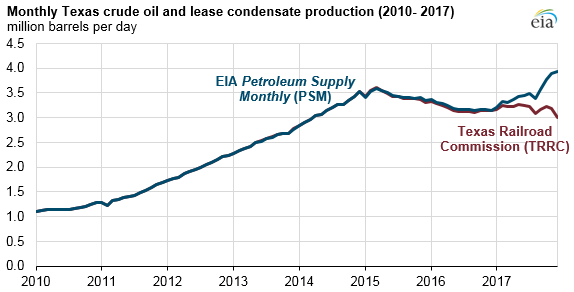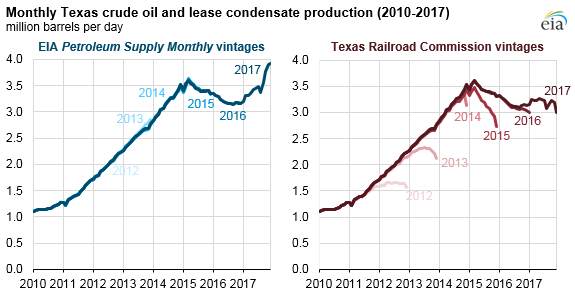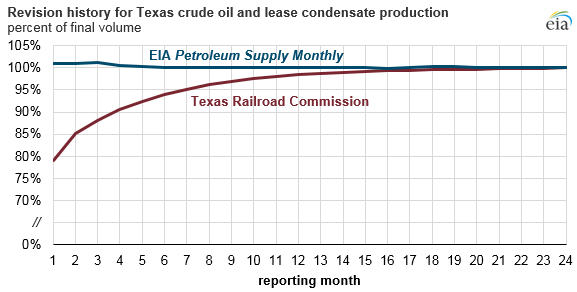Data published by state agencies, like the Texas Railroad Commission, are often incomplete when first published because of a combination of late reporting and processing delays, the EIA explained today as it compared TRRC and EIA data sets.
TRRC’s most recent report (published March 2018, with estimates through December 2017) is consistent through January 2017 with production estimates in the EIA’s Petroleum Supply Monthly (PSM), but after January, the two sources diverge.
This divergence increases for more recent months: EIA’s most recent production estimates for Texas, published in the PSM on February 28, 2018, show Texas’ crude oil production reaching 3.93 MMBOPD in December 2017. Yet, TRRC’s values show production at 2.99 MMBOPD in that same month.
The 914
The EIA develops state-level production estimates for Texas based on its EIA-914 survey. The EIA-914 survey for oil production was established in 2015, in part to make up for the deficiencies of estimating based on initial state agency reports.
EIA monthly oil production volumes are different from the Texas Railroad Commission volumes initially, but as time passes, these differences diminish as TRRC updates and revises its data. The EIA said its methodology anticipates and accounts for these expected revisions.
Because the EIA’s methodology anticipates revisions, PSM estimates are generally consistent across vintages of data releases, meaning they do not show large revisions as later reports are issued. By contrast, TRRC estimates are consistently revised upward as later reports are issued. TRRC data is revised upwards over a period of one to two years.
From January 2012 through December 2015, the change in TRRC estimates for any single month has varied from 10% to 31% from month 1 to month 24, with a 12-month average increase of 21%. For the month of December 2017, the TRRC data is 24% below the current EIA estimate.
State-level reports slower, but still accurate
TRRC’s initial reports tend to be low relative to EIA’s PSM because some oil and natural gas operator reports are placed in a pending file while waiting for other state reporting requirements to be satisfied. Reports may be filed late or have other discrepancies to resolve.
Once resolved—generally these resolutions take up to two years—these reports are ultimately included in TRRC’s published reports. On average, TRRC’s published reports are within 95% of their ultimate value after seven months.
By late 2019, TRRC’s published production value for December 2017 will be about 3.93 MMBOPD, consistent with the EIA’s most recent PSM estimates.




